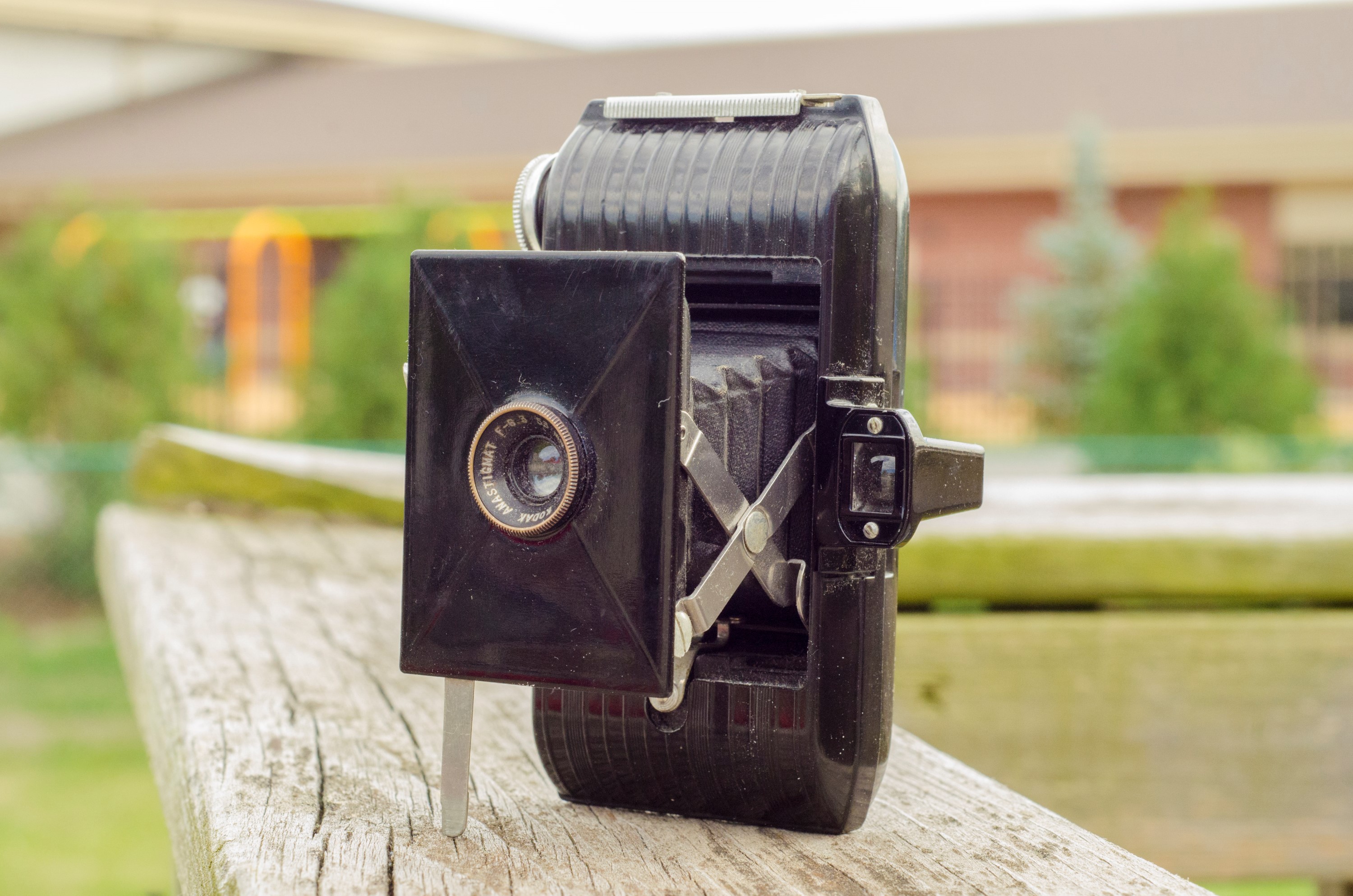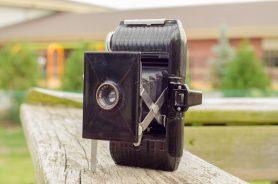This is a Kodak Bantam, a strut folding camera with an entirely Bakelite body, a single speed shutter, doublet lens, and a maximum aperture of f/6.3. This was Kodak’s first camera designed for their new 828 format of film. 828 was originally designed to be an inexpensive roll film alternative to 135 format 35mm film, but without the two rows of sprocket holes. The lack of sprocket holes meant the exposed image produced a negative 30% larger than that of 135 format film. Although 828 format film would not gain nearly the level of popularity of 135 film, it would remain in production until the 1980s. Kodak would make several other models in the Bantam line along with a few other 828 format cameras like the Pony 828.
Film Type: 828 roll film (eight 28mm x 40mm exposures per roll)
Lens: 53mm f/6.3 Kodak Anastigmat uncoated 2 elements
Focus: Fixed Focus (~6 ft to Infinity)
Viewfinder: Rigid Scale Focus Finder
Shutter: Simple Leaf
Speeds: Time and Instant only (probably 1/50 second)
Exposure Meter: None
Battery: None
Flash Mount: None
Manual: http://www.brownie.camera/brownie_user_manuals/Kodak-Bantam.pdf
History
You don’t have to be a camera collector or even a photographer to know who Kodak is. The Eastman Kodak company has been one of the most influential companies in the photography industry from the moment the company was founded in 1888, all the way to the start of the 21st century. They dominated the film and photographic paper market for over 100 years. As recently as 1976, the Kodak company accounted for over 90% of the film sold in the United States.
In addition to film and photographic supplies, Kodak had several successful lines of cameras, starting with the Brownie box cameras of the early 20th century, a long line of folding cameras, and then several inexpensive casual cameras in the mid 20th century. Chances are very good that almost every person reading this blog has an ancestor that at one time owned a Kodak camera.
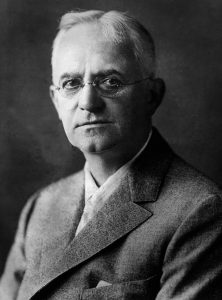
One of George Eastman’s principles in founding the company was to sell cameras cheaply to people in an effort to get them to be repeat customers by buying film and other supplies from him. This type of sales model is still used today with smartphones and video game consoles where the product is sold to the consumer at a loss to the company, with the understanding that customers will be locked in with continuing purchases.
Kodak would make no less than 30 different roll film formats starting in the late 19th century, through the first couple of decades of the 20th century. As cameras became more advanced, they also became smaller and more portable. In order to make smaller cameras, smaller film stocks needed to be used. Some creative camera makers began the practice of using 35mm cinema film in their ‘miniature’ still cameras. Cinema film was inexpensive, plentiful, and allowed for smaller cameras. Although some examples of cinema film being used in still cameras existed as early as 1905, it wouldn’t be until Leitz would release the original Leica I in 1925 that a widely accepted camera would use 35mm cinema film. Here is a link to a website that shows a list of early cameras to use 35mm film.
Although the use of cinema film was growing in popularity, there wasn’t a consistent method in which to load and advance the film in the cameras designed for it. Many times, the 35mm film would require specialized film canisters that may or may not have required a dark room to load and unload.
In 1934, Kodak would attempt to solve this problem by releasing a new film standard called format 135 35mm film which used a velvet lined metal cassette that would allow the film to be loaded into a camera in daylight. The film would be wound onto a takeup spool while shooting in the camera, and upon reaching the end of the roll, would be rewound back into the original cassette so it could be removed in daylight and sent in for developing.
135 format film turned out to be wildly popular and by the end of World War II became the most commonly used ‘miniature’ film format in the world. It would continue it’s popularity to this very day and is one of only two film formats still widely available.

While 135 format film was extremely popular, it wasted space on the film stock by having two rows of sprocket holes above and below the exposed image. These sprocket holes were designed for cinema cameras that needed to continuously move, but in a still camera, they weren’t actually necessary. These sprocket holes limited the size of an exposed image to 24mm x 36mm. Despite this ‘legacy’ inclusion of both rows of sprocket holes, the format was still highly successful.
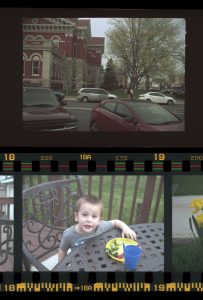
In 1935, Kodak made an attempt to popularize a variant of 35mm film without the sprocket holes which would allow for a larger 28mm x 40mm negative. This increased size allowed for a nearly 30% larger exposed negative which meant that photographs could be printed in larger sizes, while retaining more detail. 828 format film would be the same overall width as 135 format film but instead of two rows of sprocket holes, there would only be a single hole in between each frame on the film stock, so a camera would know when it had reached the next frame. 828 film was a paper backed roll film and did not come in a daylight loaded cassette. This likely was done to keep the costs low as Kodak probably didn’t want to eat into it’s own profits from their newly released 135 format. See the image to the left of a 28mm x 40mm image on 828 film compared to a normal 24 x 36mm image on standard 35mm film.
The Kodak Bantam being reviewed here was the very first camera designed to use 828 film. It would launch an entire series of Bantam cameras that would be produced through the 1950s. Although the Bantam series was generally aimed at the low end of the market, there would eventually be a couple of higher spec 828 cameras like the Bantam Special and Bantam 4.5. Kodak was the primary maker of 828 film cameras, but there were 828 cameras made by other companies such as the Argus Model M and Photavit 828.

The Bantam was designed by industrial designer, Walter Dorwin Teague who had a long history designing cameras for Kodak and other companies. He helped create the unique lines of the Bantam series, along with the Kodak Jiffy, Brownie Special, and Medalist.
Two Bantam models were available upon the release of 828 film, the Bantam 6.3, and a more basic model with an f/12.5 doublet lens. These first Bantams had rigid viewfinders, but these would be replaced in 1938 with models with flip up finders. The one reviewed in this article is an earlier model with the rigid viewfinder.
Almost all Bantam cameras were folding cameras held open by ‘scissor’ struts like the earlier Kodak Jiffy. The Kodak Special from 1936 was a high spec clamshell model that more closely resembled the design of a Kodak Retina, and the Bantam f.8 from 1938 had a solid bodied front lens that had a sliding box instead of a folding bellow system. Perhaps the most successful in the Bantam line was the Bantam 4.5 and Bantam Flash models from 1938 and 1947 respectively. Together, these two models accounted for a majority of the sales of Bantam cameras and 828 film.
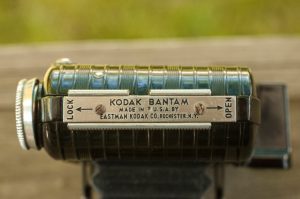
Kodak would continue to produce 828 format cameras until the early 1960s, at which time the company would stop making new models. Despite no longer releasing any new models, it would continue to support the film standard until 1985.
During my research for this article, I could not find any conclusive evidence at how well 828 film sold. On one hand, it was made for nearly 50 years, but based on the lack of many models that supported it, I just don’t think that 828 really caught on that well. Aside from the Bantam Special which was only available for a very short period of time, there were no other medium to high spec cameras that used the format.
Today, Kodak Bantams have a small, but loyal following among people who appreciate their uniqueness. The increased image size gives a bit more detail than a standard 35mm image which partially bridges the gap between 35mm miniature film, and medium format images. While 828 film is a pretty obscure format to find today, some 828 enthusiasts roll regular 135 format film into 828 spools and shoot with it. Shooting 135 film in a 828 means that the sprocket holes will be visible in the exposed images, but for a vintage collector, this is rarely a deal breaker. More ambitious fans of 828 film can cut down 120 roll film to the same size as 828 film and use that instead.
Perhaps the world’s authority on 828 film, Adam Paul has an entire article explaining how he cuts down 828 film using 120 film in a custom rig he made using a TLR and some razor blades. His process is one of only a few people willing to make “new” 828 film using stocks like Kodak Portra and Fuji Neopan which never existed when the format was widely available.
My Thoughts
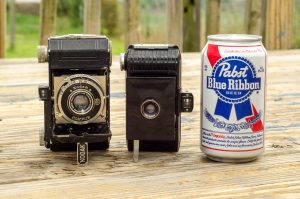
I picked up this Bantam in the fall of 2015 with several other cameras from a collector who was liquidating his collection. He had a table of cameras for $5, and most of them were complete junk, but I saw this little thing sitting there and the only reason it caught my eye was because of how small it was. I didn’t even realize it was a Bantam at first. I picked it up, handed him a five-spot and went on my way.
At the time, I never thought I would find the time to shoot it, after all, it uses extinct 828 film and its not easy to come by. It wasn’t until I started talking to my friend Adam who became an 828 enthusiast where I considered it. He saw the appeal of the 828 format because of it’s slightly larger negative size, and the fact that it often resulted in cameras much smaller than most 35mm cameras.
Sensing that I required a bit more persuasion, he took it upon himself to send me a ‘box o’ goodies’ loaded with two rolls of 828 film. One, a sealed box of Kodacolor II from around 1984, and the other a fresh roll of Kodak Portra 120 film that he had cut down himself and rolled onto an 828 spool.
Sensing the unique opportunity to shoot an unused 30+ year old roll of 828 that managed to escape the perils of time, and a fresh roll of a type of film that never existed when this camera was in production, I knew I had to pick and choose the right time to shoot with this camera. I didn’t want this to be a spontaneous roll that I wandered around my house hoping for a good shot. That opportunity took a while to reveal itself, but then in July, 2016, I had a work trip to Toronto and I knew I’d have a free evening to go sight seeing. My office is about 75 minutes away from Niagara Falls, so I loaded the Kodak Bantam with the Kodacolor II and took it with me.
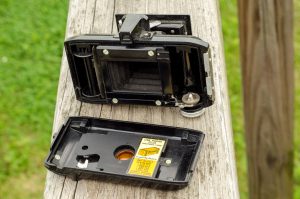
If it’s not obvious that the Kodak Bantam is a compact camera, it is more so obvious when you take it out shooting. In fact, it’s size almost worked to the camera’s detriment as for about 10 minutes in a souvenir shop in Niagara Falls, I lost the camera as it slipped out of my camera bag while I was looking at T-shirts. It wasn’t until about 10 or so minutes later when I was standing in line at Wendy’s to try out something called a “Baconator” where I noticed my camera bag was sans-one camera.
I immediately panicked and left the line and retraced my steps. First it was to the Niagara Brewing Company where I knew I had last seen the camera. I asked the barely 21 year old bartender where I had been sitting if I left a camera behind. I doubt I could have sufficiently explained what a Kodak Bantam looked like to someone of her generation, but sadly, she said she didn’t see anything that I had left behind.
I walked up the street to a souvenir shop where I picked up a shirt for my son and after walking up and down every aisle scanning for a small black plastic box, there it was, sitting nicely on the top of a pile of T-shirts. It was so neatly sitting there that it looked like the camera was placed there by someone. I wonder if someone saw it, not knowing what it was, or had it been more obviously something of value, if it would have been taken. In either case, I got my camera back no worse for wear so I went back outside. I never did go back to Wendy’s and try that Baconator. I guess it’ll have to wait til next time. With the drama of losing a camera that took me so long to find an opportunity to shoot (in a foreign country no less), I concentrated on using the Bantam.
Shooting with the Bantam is similar to that of a box camera. This model has a fixed focus two-element lens that keeps everything 6 feet and beyond in focus. It offers two aperture sizes, small and large which translate to around f/6.3 and f/11 via a sliding metal plate with two round holes in it. The shutter is a simple spring loaded flap of metal with only a single speed and “T” mode. Although the camera lacks a proper “Bulb” mode, there is a threaded socket for a shutter release cable if you needed it. The manual does not specify at what speed the shutter fires in instantaneous mode, but its probably somewhere around 1/50th of a second like most single speed shutters of the era. Later Bantams like the 4.5 and Bantam Flash have more advanced lenses with the ability to focus and change apertures, but this is a pretty basic model without those luxuries.
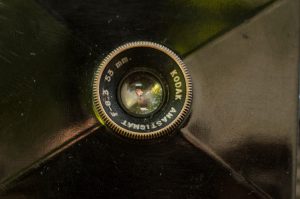
It’s the primitive feature set that makes the Bantam such a fun camera to use. While any manual camera requires some degree of preparation, the Bantam requires a bit more since your exposure options are so limited. Is my lighting appropriate for the shutter speed and aperture I’ve selected? You also need to make sure that whatever you are trying to shoot is more than 6 feet away to take advantage of the camera’s fixed zone focus.
Adding to the complexity was the fact that I was shooting 30+ year old color film. Any time you shoot with expired film, there’s an unofficial rule of “overexpose 1 stop for every decade past the expiration date”. Kodacolor II from the 1980s was an ASA 100 speed film. If I overexpose by 3 stops, then I need to act as though I am shooting with an ASA 12 speed film. When shooting outdoors, I regularly use the Sunny 16 rule which says that you should use the reciprocal of your film speed as your shutter speed, and then for brightly lit outdoor scenes, set your aperture to f/16. Had I been using a more capable camera, I would set my shutter speed to somewhere around 1/10 and f/16 for bright lit sunny scenes. But the Bantam, neither has a 1/10 shutter speed or an f/16 setting. I am forced to use an approximate 1/50 shutter speed and either an f/6.3 or f/11 shutter speed. So lets do some math…
Warning: If you have no interest in boring exposure math, just skip this next section and go back to safety.
I need to figure out what the Sunny 16 equivalent of shooting ASA 12 speed film at 1/10 second and f/16 would be using the Bantam’s available shutter speeds and aperture sizes.
1/50 is roughly two stops faster than 1/10 so I need to open my aperture two stops to compensate for the faster shutter. Two stops faster than f/16 is f/8. 1/50 at f/8 is roughly the same as 1/10 at f/16.
The Bantam can’t shoot at f/8, it can only do f/6.3 or f/11. Since f/6.3 is an oddball aperture size, I’ll just round it to the nearest “common” aperture, which is f/5.6 which is one stop wider than f/8. This is what we call in the film industry as “latitude”. Film is extremely forgiving. As long as I am plus or minus 1 stop off from proper exposure, my shots should still turn out OK. Had I been shooting black & white, I would have even more latitude.
Ok, so back to the math, I know that if I am shooting in bright sunlight using ASA 12 speed film and I only can use a 1/50 shutter speed, I need to be at f/8 for proper exposure. Since I don’t have f/8 and am forced to use f/6.3 which is close enough to f/5.6, I need to either change my shutter speed (which I can’t), my film speed (which I can’t), or I just need to change my lighting. Tada!
Since f/5.6 is one step wider than f/8 I need to shoot in a little less than bright sunlight. Had I been using Sunny 16, this would be equivalent to an f/11 scene which is slightly overcast. I ended up in Niagara Falls on a mostly sunny day in the evening. As the sky had already started to exhibit evening light, I already had my perfect “slight overcast” equivalent lighting.
End of Boring Exposure Math
So now that I had my camera loaded with film that could properly be exposed with a fixed shutter speed and single aperture (I never used f/11), I just knew that everything had to be no closer than 6 feet away and I would be good to go.
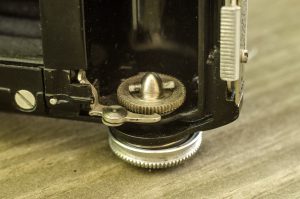
For as complicated as the math above might have seemed, now that I knew I was all set to shoot in my surroundings, it was a relief to not have to worry about it. The only things I needed to be concerned with was composition, and remembering to advance the film after each shot. 828 film has a single sprocket hole in the film to indicate the next frame. Despite the simplicity of this camera or 828 film, this is a very welcome feature that takes the worry out of winding the camera to your next frame. If you don’t want to trust the automatic stop at the end of each new frame, there is also an amber window in the film door which shows frame numbers on the film backing. The Bantam does not have double exposure prevention, so pretty much the only thing you do need to remember is to advance the film after each shot.
One thing that is immediately evident when shooting with the Bantam is that the viewfinder offers a wider view than a typical 35mm camera. While I understand an 828 negative is 30% larger, I didn’t really think I would notice the difference in shooting. On my trip to Niagara Falls, I also brought my Argus C3 since I hadn’t used it in a while and found that I enjoyed framing my shots with the Bantam much more than with the C3. The viewfinder seemed larger and more suited to the street scenes I was photographing at Niagara. The landscape shots of the falls themselves seemed to suit the 28mm x 40mm frame better than a standard 35mm frame.
With the relief of exposure and focus, armed with an extremely compact camera with a surprisingly large and useful viewfinder, I found myself enjoying the Bantam much more than the Argus C3 which I have quite a bit of experience with. If I had one disappointment, it was that the original 828 film was designed for only 8 exposures per roll and I went through it far too quickly. The custom cut roll of Portra that Adam sent me is longer and should get me close to 15 shots, so I will definitely appreciate that roll once I get around to shooting with it.
This brings me to the most disappointing attribute of an 828 format camera which is that the film format wasn’t very successful. Aside from the Bantam line (and it’s later Pony replacement) there aren’t many models to choose from. I often wonder what shooting with a modern rangefinder or SLR might have been like had 828 succeeded instead of 135? The larger 28mm x 40mm frame would have allowed for larger and more detailed exposures. The cameras themselves could have been even more compact. Heck, even now in the digital age, we would be shooting with DSLRs and mirrorless cameras with larger sensors since the digital revolution mimicked the original “full frame” 35mm exposure size. 828’s widespread success wasn’t meant to be I guess, so I’m thankful to have this experience, even if it’s not one I’ll get to repeat often.
My Results
Knowing I was using a primitive single speed camera from the 1930s with film expired more than 30 years and having to do crazy math to even guess at getting exposure right, I knew I was asking a lot of the little Bantam. Upon receiving the scans back, when I saw the images, I could see that despite my best efforts, the film I had used was a bit too far gone. The thing with using expired film is that it’s condition varies wildly. You could try two different rolls of 1980s era Kodachrome II and get wildly different results using the same camera.
The images came back extremely underexposed with obvious rippling to the film itself. In addition to the issues with the exposure and the film, there were pinkish orange orbs from where light had passed through the orange film counter window in the back. I find this curious as this was a real roll of 828 film and not something that was respooled from a much more sensitive film stock. This film should have had no issues with the window in the back, but obviously it did and the orbs were visible in all 8 shots. For my next roll through the Bantam, I will have to improvise something on that back window.
For now, here are 3 shots from that roll, along with heavily Photoshopped versions of the same images. You can at least see that there is some detail to the image. If you zoom into the Maid of the Mist boat, the boat is sharp and nicely rendered. Its hard to see, but it doesn’t appear as though there were any focus issues with the camera at infinity. There is likely nothing I could have done to prevent the rippling of the film, and the orbs still puzzle me, but it looks like despite my best effort, I would have needed at least another 2-3 stops of overexposure to get anywhere near proper exposure using this film.
Despite these results, I am still pretty optimistic about the Bantam. I’ll sort out the film counter window and try my luck at fresh 828 film and see what happens.
Edit 6/5/2017: I originally wrote this review in the summer of 2016 with the intent of taking the camera out again and shooting a second roll through it. My hope was by using more viable film, I would get a better idea of what it was capable of. In the year that has passed, I have never come back to the camera, so I decided to post this review in it’s current state. I do not believe the poor images I got are representative of the Bantam, but in the last 12 months I never found the time to shoot it again, so I wanted to share with you what information I had written thus far.
Since writing this review, I have acquired a Flash Bantam with the Anastar 4.5 lens which is a much better example of what an 828 film camera is capable of. In the event I ever want to shoot 828 film, I would be more likely to use that camera as it has a much better lens and shutter and is capable of far better shots.
My Final WordHow these ratings work |
The Kodak Bantam was the 1930s equivalent of a point and shoot camera. Although it lacked modern conveniences of auto exposure and auto focus, it had just enough features to make for a capable shooter. The camera is incredibly small and light weight and fits into nearly any size pocket. Although 828 film would never catch on as a dominant alternative to 35mm, it likely met the needs of those who didn’t want to spend much on a camera, but still wanted respectable snapshots of family events. The Bantam with the 6.3 lens is a curious remnant of the past, and although it does nothing spectacular, it was a fun and extremely portable camera to shoot. If you find one for cheap and have access to working 828 film, I think it’s worth checking out, if only for it’s uniqueness. | ||||||
| Images | Handling | Features | Viewfinder | Feel & Beauty | History | Age | |
| 1 | 2 | 0 | 0 | 1 | 1 | 40% | |
| Bonus | none | ||||||
| Final Score | 7.0 | ||||||
Additional Resources
http://camerapedia.wikia.com/wiki/Kodak_Bantam
http://camera-wiki.org/wiki/Kodak_Bantam
http://kodak.3106.net/index.php?p=209&cam=1286
http://photo.net/classic-cameras-forum/00ZVEq
http://quirkyguywithacamera.blogspot.com/search/label/828%20Film

